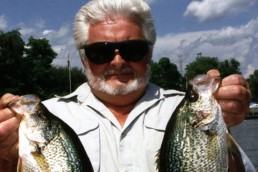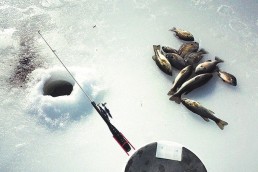Catching Suspended Panfish in the Abyss
SHARE THIS POST
Both bluegills and crappies often suspend or move out over deep-water basins on many bodies of water each winter. “Deep” and “basin” are often relative descriptions for a large, offshore bowl of deeper water; more specifically, look for bowls or basins that bottom out between 15 and 45 feet of water. This is your best bet for catching suspended panfish in the abyss. Most of these basins typically have soft bottoms, but points and other structures that protrude into these basins are often comprised of a harder bottom structure. Rock that intersects or protrudes into a basin is really an overlooked location for panfish. Yet often, we find fish drifting through this open water, suspended off the bottom—particularly if there is no obvious structure to concentrate them in specific areas.
Breaking down these basins for suspended fish can be intimidating, but there are many adjustments you can make to become much more efficient at finding these fish. Typically, finding fish is everything. Large, aggressive presentations can shine for eliminating barren water and finding fish. By midwinter however, even basin fish can sometimes require finesse.
These schools of fish often suspend in a column where fish stack on top of each other. You might have ten to fifteen feet of fish schooled below you, while somebody ten yards away isn’t marking a fish. These suspended basin fish are also typically moving. Even if you have ten to fifteen feet of fish below you, in a blink, these fish could be gone.
Because basin fish do roam so much, there are basically two strategies for locating and catching them. The first strategy is to sit in one location, where you have a consistent flow of fish swimming underneath you. The second strategy is to be much more aggressive, and drill a grid of holes, where you can be much more mobile to contact roaming schools of fish. This more aggressive approach can become even more effective if you can fish away from anglers. Roam and explore holes, and when your buddy finds them, fish right next to him until you lose the fish, and then team up to find the next pod of fish.
What can also be surprising at times is how basin fish respond to fishing pressure. There are times when the fish simply slide off ten feet away, so don’t be afraid to drill a lot of holes.
If you are going to simply be patient and hunker down on one location, you are basically just running traffic…picking off fish as they swim by. This do-less approach can be just as effective, particularly during tougher bites or if you are fishing alone. It almost seems like the fish are swimming in a circle, and the same school of fish swims by every half hour. The less people around you, the more the fish get to swim uninterrupted, until they swim underneath you again.
Here are a few additional tips and insights for pinning down suspended midwinter panfish over basins.
Rocking the boat
When fishing through several holes, turn your Vexilar to Manual Range, so you can get a bottom lock faster and walk from hole to hole quicker. Don’t fish until you see fish. Hang the transducer just below the ice, and with your sensitivity or gain turned up, rock the transducer from one side of the hole to the other. If the fish are off to the side, you can often pick fish up on the edge of the cone angle, and tell what direction from the hole the school of fish is located. Immediately drill several holes in a rough grid, and walk from hole to hole, quickly scanning each with your electronics. Don’t stop to fish until you see fish.
Heavy metal
When you find an area that is holding fish, half the equation is finding the fish. But remember that over basins and open water, the fish also don’t usually have a problem finding you. Visibility is often excellent, where fish can see your presentation from several feet away.
When I am first breaking down a location, I often try to amplify that even more by fishing with large, aggressive lures, and fishing those lures high in the water column. I often find that I catch some of the largest panfish in the school (both bluegills and crappies) by fishing big and high. In fact, we recently filmed and aired a television episode, which is on our YouTube channel called Heavy Metal Crappie. We used CPT Pinhead Minnow Spoons, and aggressively fished these spoons high in the water column with no bait.
Flutter spoons, horizontal swim lures like Salmo Chubby Darters and other high-visibility presentations often trigger big fish, not just because of size and profile, but because fish can see these lures from several feet farther away. If you can fish several feet above the fish, guess which fish climbs up several feet the fastest? Usually, the bigger fish.
Chain gang
I have often been surprised that more bluegill and crappie anglers don’t use droppers or chains below spoons. Often regarded as a perch tactic, chain droppers can work excellently over basins when the bite is off, because they provide the weight and flash of a spoon with the delicate finesse of the dropper. Especially with bluegill and sunfish, chains can be flat-out deadly when fish get finicky.
As a rule of thumb, we see many of these open-water basin bites get more difficult as the winter progresses. Chain droppers can be difference-makers and are very overlooked by many anglers.
Are you enjoying this post?
You can be among the first to get the latest info on where to go, what to use and how to use it!
Doldrum adjustments
Our first adjustment to slow or difficult conditions is often dropping down to lighter line. We often do most of our heavy lifting with 3-pound Frost Mono for a big percentage of our panfish ice fishing. That 3-pound mono is just perfect diameter and very versatile. On tougher bites, however, try scaling down to 2-pound Frost Fluorocarbon. The weight and low stretch attributes of Fluorocarbon are nice over deeper water.
Something else to consider is to change your line often, as much as every day to two days of fishing. If you jig aggressively to bring fish in, you can really work twist into the line when you hard-pound jigs on light diameter lines, regardless of which reel you use. When bites get tougher come midwinter, change your line all the time. You don’t have to change the entire spool—just the top 50 feet.
Tungsten love
Regarding small profile horizontal and vertical ice jigs for panfish, I prefer tungsten jigs when fishing these suspended fish. There are many reasons why I like the extra denseness or weight of tungsten. The biggest advantage of tungsten, in my opinion, is that the extra weight makes the entire presentation more sensitive, and you can sometimes get away with using heavier line like 3- or 4-pound test. Tungsten will often make 3-pound test feel like 2-pound test. The advantages of tungsten become even more apparent when you really must scale down to the smaller sizes.
Classic tungsten jigs that have become popular with winter panfish anglers include the Clam Pro Tackle Drop Jig. On the toughest bites, experiment with some of the vertical, tear drop style tungsten jigs like the CPT Half Ant. Vertical jigs seem to offer a subtler footprint and smaller profile when fish are looking up at the jig.
Use horizontal jigs and soft plastics to find fish. Use vertical jigs and live bait like waxworms to keep catching fish when they get tougher, after you start to wear out your welcome.
Bait debate
Soft plastics like the original Makki paired up with a horizontal tungsten jig have probably been one of the hottest crazes over the past decade, and for good reason. I personally use soft plastics whenever I can, because I like the durability and action of soft plastics. Soft plastics, however, are not the be-all-and-end-all. On tough bites, there are still situations where live bait like Eurolarvae and waxworms reigns king.
I often look at the ceiling in which fish will climb as the indicator between using plastics and bait. If fish will accelerate and rise three feet or more to hit a presentation, I will often use soft plastic all day. If fish wont accelerate, and barely budge a foot or less in the water column, expect the bite to be tougher, and expect live bait to save the day. Especially with big sunfish and bluegills, waxworms and grubs can be key on tougher bites.
Round up
These classic basin and hole locations are prevalent on many fisheries. You can often see where these holes are located on many lakes by just looking for the cluster or permanent ice shacks. By midwinter, these fish can get picked over.
One final thought to wrap up with is simply fishing new ice. Push to the edges of community holes. Find locations that haven’t been fished recently. Even a ten-yard shift away from the commotion and harassment can be a big move. Look over topo maps and look for areas within the basin holding fish that just haven’t had as much pressure. Finding and catching these fish by midwinter is as much about getting away from the crowds as anything else.
Become a MidWest Outdoors Insider here!
MWO
SHARE THIS POST
Did you enjoy this post?
You can be among the first to get the latest info on where to go, what to use and how to use it!
Jason Mitchell
Jason Mitchell was a top walleye guide on Devils Lake, N.D. for nearly 20 years. Today, Mitchell produces the Jason Mitchell Outdoors TV program. Visit jasonmitchelloutdoors.com for more.



